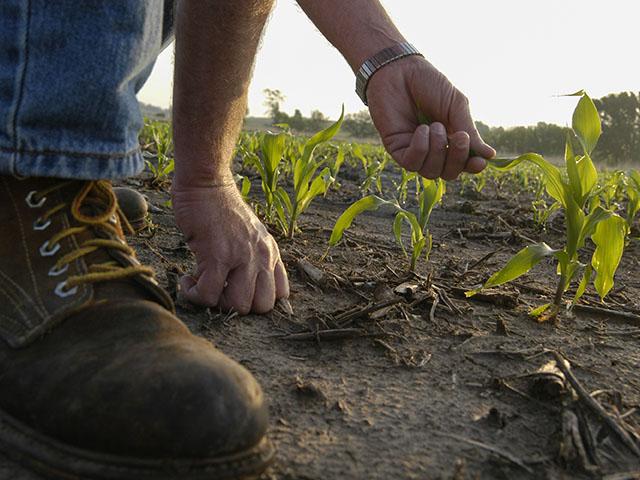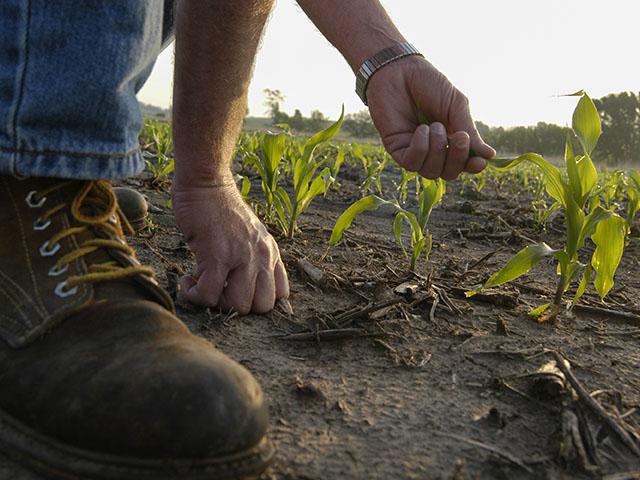Production Blog
Watch Corn and Soybean Crops Now for Stresses Later
As pest warnings heat up along with the temperatures, farmers also need to consider what clues the crop is offering for later management.
Putting boots in the field will be especially prudent this year, said Nick Frederking, an AgriGold field agronomist and southern Illinois farmer.
"People were pretty excited when they got quite a bit of the crop planted early," said Frederking of the territory he covers in the southern half of Illinois and parts of Indiana and Missouri. "As corn started to tap into nitrogen and the plants greened up, things looked mostly good from the roadside. But when you start to walk out into some of these fields, we're already seeing some issues that have probably been going on since the start of planting and aren't being accounted for."
The week of April 10-15 was a strong planting window for much of the region he oversees. Potential problems started with the cool, wet conditions that followed planting and several weeks following germination. That put protection from seed treatment at risk and left some stands vulnerable to below-ground pests and pathogens, he noted.
"That seed treatment is only active for approximately 21 days," he explained. "In an ideal season, the corn plant gets out of the ground within seven days and has protection for the next two weeks until the plant is big enough to defend itself. But if the plant is just emerging at two weeks, it will be more vulnerable to pest and disease pressure."
Wireworm, white grub and seed corn maggot are all insect issues that threaten unprotected corn stands. Bean leaf beetle can sneak in on soybean. The most common seed and seedling diseases of soybean tend to be Fusarium, Rhizoctonia, Phytophthora and Pythium.
P[L1] D[0x0] M[300x250] OOP[F] ADUNIT[] T[]
"We saw some plants from that planting period sawed off below ground. In other cases, we were digging the plant up and inspecting the early root formation and finding discoloration or decay. We may have taken stand counts at emergence, but I'm confident those will not be our final stand counts at harvest this year in some fields," Frederking said.
The damage is about as variable as the spotty rain that has fallen, he added. "We had some farmers replanting corn near central Illinois at 3.5 inches just to find moisture near the end of May. Drought is a factor, especially in the northern end of my territory, but corn that has rooted well is hanging on."
It helped the crop conserve moisture when temperatures dropped off those 90-degree and above temps that hit in late May, he noted. But he said there's no question much of the region he covers has been subjected to drought stress.
"If there is a bright spot it is that there is no better time, in my opinion, to go through drought stress than when the crop is in early growth stages. We compact those nodes on a corn plant and lessen the risk of green snap through rapid growth. At this point, the girth or rows around have been determined on a lot of acres. Right now, we're starting to establish ear length and that's less of a factor in the yield picture," he said.
Frederking saw somewhat similar growing conditions last year, although the 2023 season got off to an earlier planting start on average. "Last year, we did have quick emergence, and the plant got big enough to protect itself a little better.
"I'm rolling the dice a little saying this, but I'm worried that in some of our area, we could see more late-season problems due to pathogens and disease hanging out inside the plant. They just haven't shown their ugly faces yet," he said.
That means watching for diseases such as crown rot and stalk rots in corn and sudden death syndrome in soybean. Pests such as corn borer, armyworm or corn earworm can induce stalk rot or open a plant to infection -- impacts that can plague farmers season long.
"I've been telling farmers to make note of the fields they planted first and start evaluating mid-season. We may have to prioritize them for harvest," he said.
For a regional report of conditions in Illinois go to: https://www.ilsoyadvisor.com/…
For reports in Iowa: https://crops.extension.iastate.edu/…
For a report on crop conditions from Michigan State University go to: https://www.canr.msu.edu/…
For the latest information from Purdue University on crops news in Indiana: https://extension.entm.purdue.edu/…
For recent information on crop conditions in Kentucky: https://www.kygrains.info/… and https://graincrops.ca.uky.edu/…
For recent Minnesota crop news: https://blog-crop-news.extension.umn.edu/…
Pamela Smith can be reached at Pamela.smith@dtn.com
Follow her on Twitter @PamSmith
(c) Copyright 2023 DTN, LLC. All rights reserved.








Comments
To comment, please Log In or Join our Community .